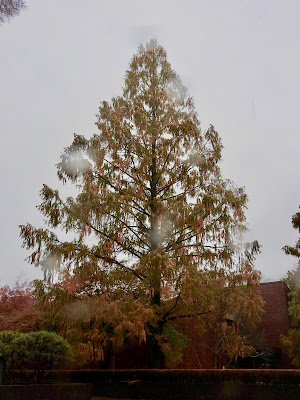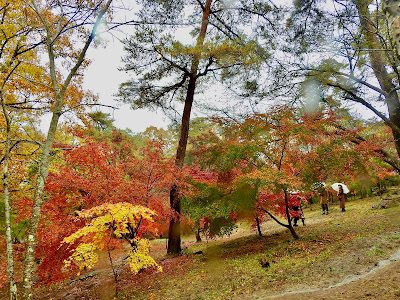 |
| 長瀞 / Nagatoro |
 |
| 長瀞へのツアー 私と夫Rは長瀞 (ナガトロ) へ日帰り旅行をしました。 Tour to Nagatoro I and my husband R had a day trip to Nagatoro.  11月23日の予定 Itinerary on 23rd of November in Japanese |
目次 / Contents
1) 月の石もみじ公園 / Tsukinoishi Momiji Park
2) 自然の博物館 / Saitama Museum of Natural History
A. カエデの森 / Maple Forest
B. 日本地質学発祥の地 / Birthplace of Geology in Japan
C. 博物館からの景色 / View from Museum
1) 月の石もみじ公園
Tsukinoishi Momiji Park
Tsukinoishi ; Tsuki-no-ishi means Stone of Moon and Momiji means Japanese maple.
 |
| 地図上 : 西 ; 宝登山 (ホドサン) / 宝登山神社 / 宝登山ロープウェイ 中心 ; 長瀞駅 中左:自然の博物館 / 月の石もみじ公園 下; 岩畳 / 荒川 (ライン下り) Nagatoro Map in Japanese Up on the map : West ; Mt. Hodosan, Hodosan Shrine, Centre ; Nagatoro Station Centre left : Saitama Museum of Natural History Tsukinoishi Momiji Park Bottom ; Iwadatami Rocks, Arakawa River 月の石もみじ公園 のハガキ 夜はライトアップされるようです。 その素晴らしさを想像するのは容易でしら。 チケット代わりに、ライトアップされた写真の ポストカードをいただきました。 Postcard of Tsukinoishi Momiji Park It seems to be lit up at night. It's easy to imagine how wonderful it is. Instead of a ticket, I received a postcard with an illuminated photograph. |
月の石もみじ公園の名前は、
高浜虚子 (タカハマキョシ/ 1874 - 1959) が詠んだ俳句
「ここに我 句を留むべき 月の石」
に由来します。
仲秋の名月をイメージして詠まれたとのこと...
私には句の意味がよく理解できません...トホホ。
公園内に句碑が建てられているそうですが、私は見ませんでした。
 |
| 約2,000m² の広さがある。 ここには50本のもみじが植えられています。 日本には28種のもみじ(カエデ)があり、 埼玉県には21種が自生しているそうです。 It has an area of about 2,000 m². 50 maple trees are planted here. There are 28 species of maple in Japan, and 21 species grow naturally in Saitama Prefecture. |
The name of Tsukinoishi Momiji Park is derived from the haiku, below written by Kyoshi Takahama (1874 - 1959).
" Kokoni-ware Ku-wo-tomubeki Tsukinoishi"
"Moon rocks that should stay here"
It was written in the image of the Mid-Autumn Moon ...
I don't really understand the meaning of the phrase ... boohoo
It seems that a monument is built in the park, but I didn't see it.
 |
| 雨の下の美しさがありますが、撮影はしにくいです。 カメラも曇るし、レンズ滴もつきます。 It has beauty under the rain, but it is difficult to photograph. The camera gets fogged and there are droplets on the lens. |
どこもかしこも、燃えていて、雨の中で、興奮しました。
私の撮影は私の感動に振り回されていました。
私よりもRは紅葉好きなので、彼の喜びは私以上だったと思います。
Everywhere was on fire and I was excited in the rain.
My photographing was made a fool of by my excitement.
R loves autumn leaves more than I do, so I think his joy was more than I mine.
 |
| 英国の"ウェストンバート国立森林公園" (Westonbirt Arboretum) を思い出しました。 そこでも、素晴らしい紅葉を見ることができました。 "ウェストンバート国立森林公園"の公式サイト : ★ (英語のみ) 日本語で説明されているブログがありました→★ I remembered 'Westonbirt Arboretum'' in Britain. I was able to see the wonderful autumn leaves there as well. Westonbirt Arboretum's official Website: ★ |
 |
| 荒川が見えます。 I can see Arakawa River.  |
 |
| '地球の窓 'にかかるもみじ 長瀞で見られる岩石、結晶片岩 (ケッショウヘンガン) は、 地下深く高圧下でつくられたものです。 その片岩を見ることから「地球の窓」といわれます。 Maple on 'Earth Window' The rocks found in Nagatoro, Crystalline Schist, were formed under high pressure deep underground. Here is called "Earth Window" because we can see the schist. |
 |
| もみじと滴 滴が綺麗だったので撮影した写真です。 Maple and Drops I photographed this because the drops were beautiful. |
2) 自然の博物館
Saitama Museum of Natural History
A. カエデの森 / Maple Forest
公式サイト: ★
"カエデの森"と呼ぶそうです。
博物館へ行く時間はありませんでしたが、"カエデの森"は多少、楽しむことができました。
There are also many maples in the grounds of Saitama Museum of Natural History.
It's called "Maple Forest".
We didn't have time to go to the museum, but we enjoyed a little of the "Maple Forest".
 |
| カエデの森では埼玉産21種全てを見ることができるそうですが、 私には見分けがつきません。 It seems that we can see all 21 species from Saitama in the Maple Forest, but I can't tell.  |
 |
| メタセコイヤ 背丈が高く目を引きます。 Metasequoia Tall and eye-catching. |
下記、博物館サイトより
"メタセコイアは、昭和14年(1939年)に化石が発見されました。
約70万年前に絶滅したと考えられていましたが、昭和20年(1945年)に中国の内陸部で生きているメタセコイアが発見、翌年発表されて「生きている化石」として大変有名になりました。
当館の庭には、4本のメタセコイアがあります。
当館の庭には、4本のメタセコイアがあります。
これは、生きているメタセコイア発見から9年後の昭和29年(1954年)にニューヨーク植物園から5本分けてもらったものです。
当時は30cmほどでしたが、60年以上経過し30m以上にまで成長しました。"
According to the museum website in Japanese below,
"A fossil of Metasequoia was discovered in 1939.
It was thought to be extinct about 700,000 years ago, but in 1945, a living metasequoia was discovered in China, and it was announced the following year and became very famous as a "living fossil".
There are four Metasequoias in the Museum's garden.
In 1954, nine years after the discovery of living metasequoia, five trees were given from the New York Botanical Garden to this Museum.
At that time, though they were only about 30 cm, after more than 60 years, they have grown to over 30m. "
"A fossil of Metasequoia was discovered in 1939.
It was thought to be extinct about 700,000 years ago, but in 1945, a living metasequoia was discovered in China, and it was announced the following year and became very famous as a "living fossil".
There are four Metasequoias in the Museum's garden.
In 1954, nine years after the discovery of living metasequoia, five trees were given from the New York Botanical Garden to this Museum.
At that time, though they were only about 30 cm, after more than 60 years, they have grown to over 30m. "
(Translation by me)
B. 日本地質学発祥の地
Birthplace of Geology in Japan
 |
| '日本地質学発祥の地' 碑 1993年に日本地質学会発足百周年、長瀞町町村合併50周年及び 天皇皇后両陛下行幸啓を記念して、 日本地質学発祥の地の碑が当館に建立されました。 長瀞を含む秩父エリアは、地質が異なり、 さまざまな年代の地層や岩石を見ることができます。 1878年、ハインリッヒ・エドムント・ナウマン博士 (1854 - 1927) による日本列島各地の地質調査が始まり、 博士の率いる調査団が長瀞を訪れ、 長瀞の地質学的価値の高さが認められた。 その後、多くの研究者や学生が長瀞を訪れ、秩父・長瀞地域は "日本地質学発祥の地"とよばれています。 2011年には"日本ジオパーク"に指定されました。 Monument of Birthplace of Geology in Japan In 1993, "Monument of Birthplace of Geology in Japan" was set up as Commemoration of the 100th anniversary of the establishment of the Geological Society of Japan, the 50th anniversary of Nagatoro Merger (of the town and villages) and the Visiting of the Emperor and Empress.  詳しくはこここで→ ★ ジオパーク秩父公式サイト:★ If you want know about this, you could look here →★ / ★ Chichibu Geopark official website : ★ |
The Chichibu area, including Nagatoro, has different geology, and you can see strata and rocks of various ages.
In 1878, Heinrich Edmund Naumann (1854 - 1927) began a geological survey of various parts of the Japanese archipelago, and a research team led by him visited Nagatoro, recognizing the high geological value of Nagatoro.
After that, many researchers and students visited Nagatoro, and the Chichibu and Nagatoro area is called "the Birthplace of Japanese Geology in Japan."
In 2011, the area was designated as "Japanese Geoparks".
 |
| ハインリッヒ・エドムント・ナウマン (1854 - 1927) ドイツ人地質学者で、明治政府に招かれたお雇い外国人の一人。 日本における近代地質学の基礎を築きました。 日本初の本格的な地質図を作成し、 フォッサマグナを発見しました。 ナウマンゾウに名を残すことでも知られています。 Heinrich Edmund Naumann He was a German geologist and one of the foreign employees in Meiji Japan. It laid the foundation for modern geology in Japan. He made the first full-scale Geological map of Japan and discovered Fossa Magna. He is also known for naming Naumann's Elephant. 画像は下記より/ This from below ★ |
 フォッサマグナ 青線に囲まれた薄い赤色の地域がフォッサマグナ Fossa Magna The pale red area surrounded by the blue line is Fossa Magna. 画像は下記より / This from below ★ |
C. 博物館からの景色 / View from Museum
 博物館からの景色 |
| 綺麗な色合いなのに、駐車場の P の文字が残念です。 View from Museum Although it is a beautiful colour combination, the letter P in the car park is disappointing. |
雨のために舟下りができず残念ではありましたが、'SLパレオエクスプレス'に乗れましたし、月の石もみじ公園は、予想を遥かに超える紅葉の素晴らしさがあり、全体としては満足できる旅行でした。
ありがとうございました。
It was a pity that we couldn't have the boat trip because of the rain, but we were able to get on 'SL PALEO EXPRESS', and Tsukinoishi Momiji Park has wonderful autumn colours that far exceed expectations, so I am satisfied as a whole by this trip.
Thank you very much.
岩畳については下記。/ About Iwadatami Rocks, below.































